
Connectivity is king. For the experience of those attending, to those delivering the event and those watching from afar. In the last 10 years connectivity has migrated from a nice to have to a critical system for any event that wants to engage with its audience and deliver effectively.
Good connectivity presents itself in several ways. Unfortunately for the organiser it’s critical to have an understanding of these aspects, just as they have an understanding of their audience or how many tickets have been sold.
When considering connectivity, it helps to be clear with those who you want to consider and those who you don’t.
The Organiser – local networks and the associated internet connectivity are critical for an organising team to work. Bandwidth here can normally be quickly estimated since it’s a known quantity. Cloud systems such as Dropbox and Office 365 increase requirements but are manageable even on small internet services. Systems such as Skype or more advanced video conferencing which are more common now when working with international committees, can dramatically increase requirements.
The Sponsor – the majority of activations now require some kind of high-quality connectivity. Engaging the sponsor is one thing, showing them what is possible or what can be supported with the right connectivity is next. For overlay locations local cellular (4G) services may be sufficient but within high volume areas these will most likely struggle to deliver significant bandwidth. For many events connectivity in this space is an afterthought which is problematic and expensive. Proactive discussions with sponsors at the start of any engagement will help identify what’s required and the most effective method of delivery.
The Press – considering the media appetite for the internet can make or break an event. Print media need to move images, which can be managed, but those who require outside broadcast type services generally either look to the event to help or use their own broadcast vehicles. Broadcast vehicles can be expensive so generally the approach of delivering onsite bandwidth means that more content can be pushed.
The Partners – bars (cashless) ticketing etc. Anyone who works with the organisers to deliver their part of the event. Smart tenders can mean issues relating to connectivity becomes the partners problem but many times this will add significantly to cost because everyone is doing their own thing. In many cases a shared service is preferred, like power. Cashless services are critical to processing payments. Fast, secure, effective transactions are expected.
The Attendee – normally the final piece of the puzzle. Leading events are now looking to this group first, to encourage engagement and legacy, in which case services such as viewing replays, concession service to seats, emergency messaging, are all common. The network and internet required to carry attendees data can be significant, again, more lead time means more efficiencies. If attendees are not part of scope, then cellular carriers are the best route to providing a level of connectivity.
For any organiser the technical side of events continues to grow, and they must add this to their ‘toolkit’ of knowledge and experience. Just as with ticketing, marketing or venue selection, it’s critical that those in senior positions understand what is being done, what the possible risks are and what their strategy is.


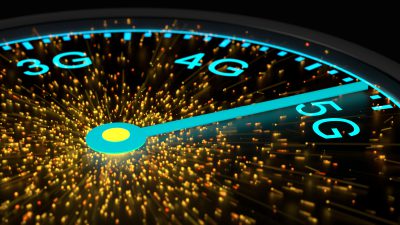
 You can get a great buzz out of attending a good event, and if you organise it the buzz is even better. Every successful event requires a team of dedicated professionals with a range of skills but often the event industry isn’t considered as a career choice.
You can get a great buzz out of attending a good event, and if you organise it the buzz is even better. Every successful event requires a team of dedicated professionals with a range of skills but often the event industry isn’t considered as a career choice.
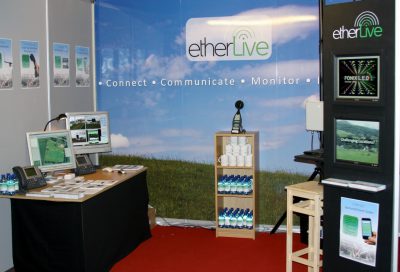
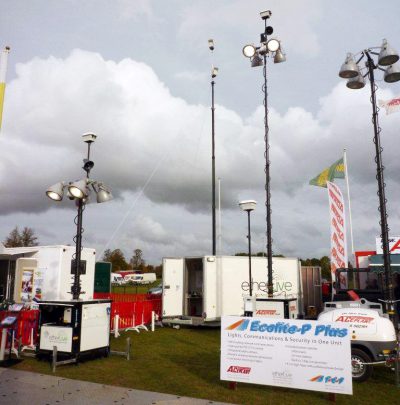 In conjunction with Ace Plant & TCP we launched the Ecolite P+ at Showman’s 2009. The Ecolite P+ was a more eco-friendly tower light using metal halide discharge lamps coupled with CCTV, Wi-Fi and a PA system. The light was palletised so that more units could be transported on a trailer and had a generator which could run for several days on its internal fuel tank.
In conjunction with Ace Plant & TCP we launched the Ecolite P+ at Showman’s 2009. The Ecolite P+ was a more eco-friendly tower light using metal halide discharge lamps coupled with CCTV, Wi-Fi and a PA system. The light was palletised so that more units could be transported on a trailer and had a generator which could run for several days on its internal fuel tank.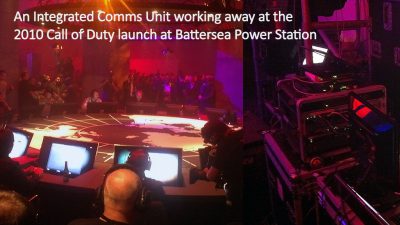
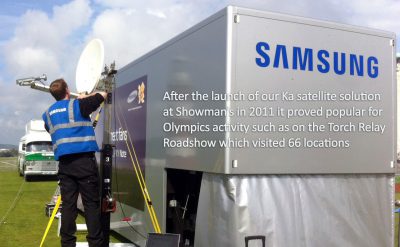 The launch of Ka band satellite internet access in 2011 radically changed the use of satellite at events. Previously satellite internet was a relatively costly and difficult proposition which didn’t give a good user experience. The Ka band internet service was designed for broadband services, rather than broadcasters, using smaller dishes and allowing multiple users to share bandwidth to keep costs down. It has proved hugely popular and is now a common sight at events. It still suffers the important limitation of all satellite services – high latency – so can only be used for certain services and is a very different user experience to other types of connectivity.
The launch of Ka band satellite internet access in 2011 radically changed the use of satellite at events. Previously satellite internet was a relatively costly and difficult proposition which didn’t give a good user experience. The Ka band internet service was designed for broadband services, rather than broadcasters, using smaller dishes and allowing multiple users to share bandwidth to keep costs down. It has proved hugely popular and is now a common sight at events. It still suffers the important limitation of all satellite services – high latency – so can only be used for certain services and is a very different user experience to other types of connectivity. Since 2010 we had been working on RFID solutions with a crew catering system and later an accreditation/management system. In 2012 we worked with Intelligent Venue Solutions to bring a number of RFID related activities under one umbrella at a spin-out stand at Showmans.
Since 2010 we had been working on RFID solutions with a crew catering system and later an accreditation/management system. In 2012 we worked with Intelligent Venue Solutions to bring a number of RFID related activities under one umbrella at a spin-out stand at Showmans.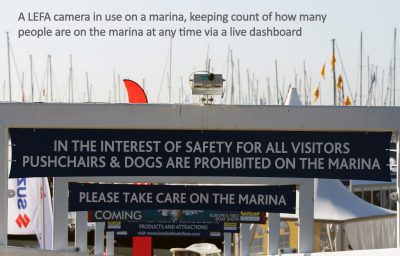 In 2012 we introduced a people counting solution which we refined and extended into Live Event Footfall Analytics (LEFA) for Showman’s 2013. Structured counting, for example in well-contained routes such as exhibitions, is now well established, whereas unstructured crowd density analysis is still an evolving area but shows great potential longer term for helping manage crowd flows and density.
In 2012 we introduced a people counting solution which we refined and extended into Live Event Footfall Analytics (LEFA) for Showman’s 2013. Structured counting, for example in well-contained routes such as exhibitions, is now well established, whereas unstructured crowd density analysis is still an evolving area but shows great potential longer term for helping manage crowd flows and density.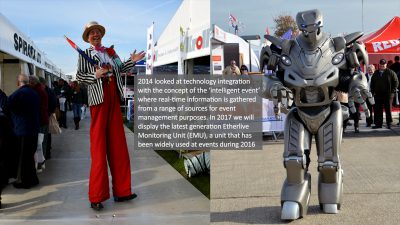 With more and more technology being deployed at events the next logical step is the integration of technology and communication between all aspects providing a rich level of event intelligence. From HD-CCTV, ticket scanning information and device location information, through to geo-tagged social media posts, a picture can be built up of what is happening on site and fed live into event control.
With more and more technology being deployed at events the next logical step is the integration of technology and communication between all aspects providing a rich level of event intelligence. From HD-CCTV, ticket scanning information and device location information, through to geo-tagged social media posts, a picture can be built up of what is happening on site and fed live into event control.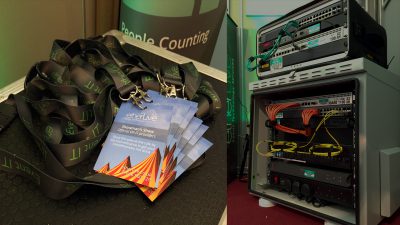 Ever increasing requirements, demand for higher speeds and more capacity had driven a rise in the amount of fibre deployed around sites. Bigger sites were typically run with a fully routed design providing improved redundancy, increased speeds and better isolation between areas. This was often coupled with multiple gigabit internet connections which were diversely routed for redundancy.
Ever increasing requirements, demand for higher speeds and more capacity had driven a rise in the amount of fibre deployed around sites. Bigger sites were typically run with a fully routed design providing improved redundancy, increased speeds and better isolation between areas. This was often coupled with multiple gigabit internet connections which were diversely routed for redundancy.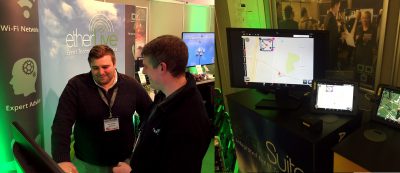 Extending on from the Intelligent Event additional components were demonstrated including Automated Number Plate Recognition (ANPR) and the Etherlive Monitoring Unit (EMU). The EMU is a type of IoT (Internet of Things) device which can be used to monitor a variety of things. It is particularly useful for monitoring power giving us early warning of power issues across a large event site.
Extending on from the Intelligent Event additional components were demonstrated including Automated Number Plate Recognition (ANPR) and the Etherlive Monitoring Unit (EMU). The EMU is a type of IoT (Internet of Things) device which can be used to monitor a variety of things. It is particularly useful for monitoring power giving us early warning of power issues across a large event site.
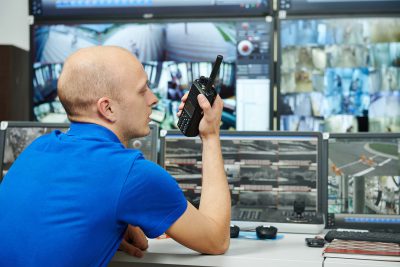
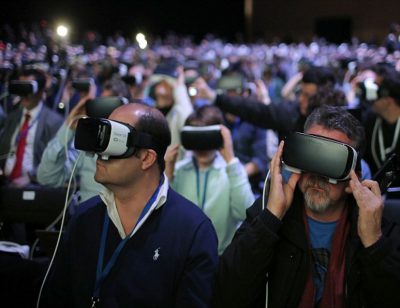 e Oculus Rift, a project which has been exciting the technology community for some time, many argue that home virtual reality has finally arrived. Cheaper projects like Google Cardboard demonstrate that even those who do not want to splash out mega bucks can get themselves a piece of the action. Alongside full virtual reality there has also been an explosion in competitively priced 360 degree cameras bringing a much broader accessibility to a more immersive video experience.
e Oculus Rift, a project which has been exciting the technology community for some time, many argue that home virtual reality has finally arrived. Cheaper projects like Google Cardboard demonstrate that even those who do not want to splash out mega bucks can get themselves a piece of the action. Alongside full virtual reality there has also been an explosion in competitively priced 360 degree cameras bringing a much broader accessibility to a more immersive video experience.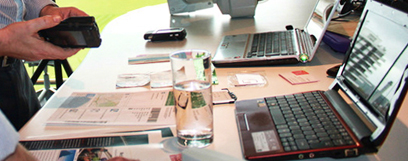 It may sound obvious but defining a clear specification for technical services means you’ll get what your event needs, when you want it at the right price.
It may sound obvious but defining a clear specification for technical services means you’ll get what your event needs, when you want it at the right price.